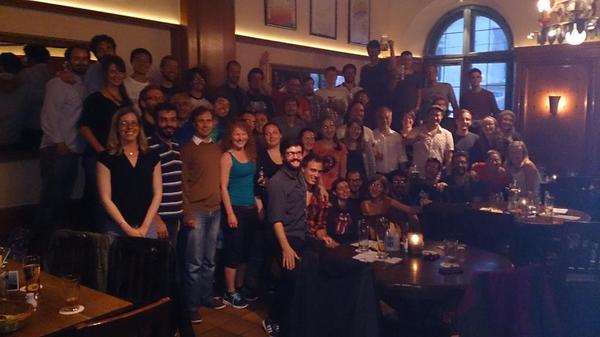Munich: Magma, Glasses and Melts
Last week I flew to Munich to join 29 other students to take part in the Magma, Glasses and Melts short course. The course is about the behaviour of magmas under certain conditions and what implications this has for volcanic activity. You also get the chance to see laboratories which replicate the conditions inside volcanoes and have helped produce the research taught in the course. It has been run annually for over a decade by the volcanology group which is headed by Prof. Don Dingwell. Don has been at the forefront of this research area for over 25 years so there is no one more suitable for teaching the course.
 |
| An explosion at Volcan de Colima earlier this year. Was this explosion started by fracturing bubbles? |
The purpose of the course is to teach about the peculiar properties of magma as it squeezes and stretches on its way up to the surface. Small changes in temperature, pressure and chemistry can have a dramatic effect on the viscosity of the magma. Viscosity is a measure of how 'sticky' the magma is, the higher the viscosity, the 'stickier' the magma. Another observation is how viscous magma can break in a brittle manner when you apply a change in stress. In other words, a material with liquid-like properties is breaking like glass when you stretch it fast enough. This begins to explain why volcanoes with particularly sticky magma undergo particularly explosive activity. For example, as magma rises it begins to release gas into bubbles, which has the effect of increasing its viscosity. If enough stress is then applied to the 'stickier' magma, it could crack and release the gas in a violent explosion. Why are you attending a course on magma rheology when you are a geophysicist I hear you ask. If you haven't guessed by now, the brittle fracture of magma is an energetic process which can produce volcanic earthquakes; the same signals which I am analysing for my project. I now have a better idea of what could be happening every time a particular earthquake occurs. This means I can design better experiments when I try to replicate these events in the lab.
 |
| Everyone involved with Magma, Glasses and Melts after a hearty Bavarian meal. (Photo by Jackie Kendrick, @RonSukiRon). |
If you are reading this and considering attending the course next year, then I really recommend you go. The course is tough and there is a lot to learn in not much time. Yet, seeing the laboratory equipment and learning from the bottom up really helps bring you up to speed with current research. I enjoyed my time in Munich, a great city full of delicious food and strong Bavarian beer. I also enjoyed meeting the other students, and it was reassuring to know they were just as confused by the course material as I was! A big thank you goes to Don Dingwell, Ulrich Kueppers, Bettina Scheu and the rest of the Munich volcanology crew for teaching a great course. I feel obligated to include a quick plug to follow their activities on their twitter account: @LMU_Volc.
Comments
Post a Comment